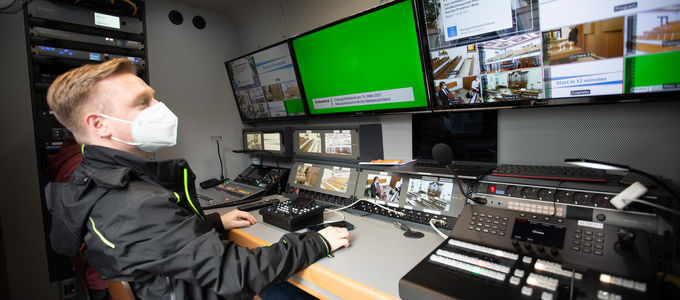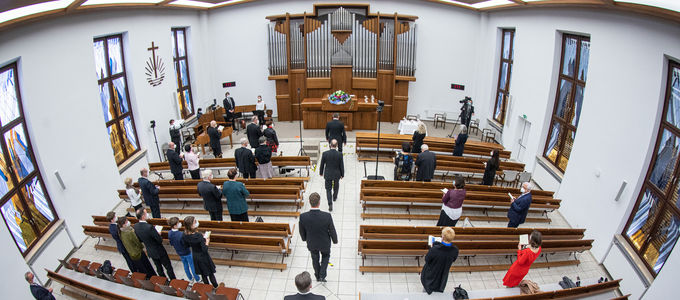
Goodbye satellites, hello more broadcasts and a broadcast license for open streaming! The New Apostolic Church is repositioning itself for divine service transmissions in Europe. The catalyst for this change is not least of all the Covid-19 pandemic.
It was a quiet premiere in mid-March in Frankfurt, Germany: the divine service incorporating the change in the district’s leadership was transmitted live throughout the region, but this time it was not the familiar OB vehicle that was parked outside in front of the church door. On this occasion it was a panel van of neutral white colour (for now anyway)—the first of three of its kind.
The vehicle is more compact because the Church is breaking new ground (in terms of its transmissions, that is): The Bischoff Verlag—the publishing house owned by the Church—is saying goodbye to satellites and switching over to the internet. Such was the decision of the European District Apostle Meeting, as this way is cheaper and more flexible.
Deployment on several levels
This new system, which will come into effect at the start of 2022, will allow the Church to broadcast even more programming than before. This will continue to include the global and regional transmissions as before, but a growing number of regional streams—for example, to the congregations within a particular Church district—will also be added.
Beyond that, our brothers and sisters in faith will also be able to connect to their congregations using their own cameras from home. According to current plans, those who do not have a computer should be able to purchase suitable receiving devices instead.
New rules facilitate access
The vast majority of these divine services are not freely available. The Church’s own IPTV portal, which is currently being expanded from 1,000 to 20,000 users (at least initially), forms the closed framework. However, the new rules will allow easier access than before.
Access will no longer be granted by the responsible Church, but by the respective congregation, for which the rector is responsible. According to the concept, the offer is intended for all “members of the congregation who are unable to participate in in-person divine services for various reasons”.
Into the public spotlight with a licence
The European Churches also want to go public with selected divine services—and on a regular basis, to boot. The frequency of such divine services is still to be clarified. For the time being, the plan is to use YouTube as the streaming channel.
Bischoff Publishers will also apply for a broadcasting license because these broadcasts meet the same legal criteria that apply to television. These include the need for a certain regularity, appointment announcements, the use of several cameras, and live broadcasts—and they must reach more than 20,000 users at a time.
Learning from the crisis
The New Apostolic Church started transmitting audio-video divine services on a small scale in 1983. The international breakthrough came on Pentecost 1990, when 270,000 participants in seventeen countries were connected via satellite. The transmissions broke new ground on the internet in 2007, but only as a supplementary channel. Technical and organisational hurdles still stood in the way of a full transition at the time, however.
It was here that the corona pandemic massively accelerated developments: when the world went into lockdown and divine services had to be transmitted directly to members’ homes, the various Churches and congregations made use of the internet’s opportunities on a much broader front. What was set up out of the blue—and on some occasions only provisionally—at the time has now been given more permanent structures.
What does the new concept mean for the Churches? More information on this subject is available at nak.org, the official homepage of the New Apostolic Church International.














